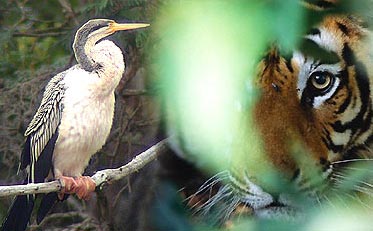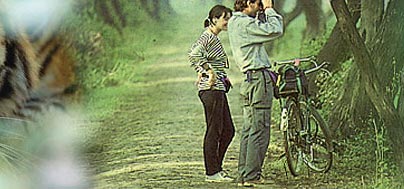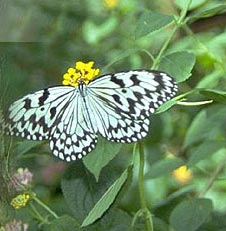 |
 |
 |
||
|
||||
India
Wildlife Information
Mammals in India
THE WORLD OF MAMMALS
Mammals are the most charismatic of all fauna. Perhaps it is because we belong to the order ourselves that we find them of perennial interest. Majestic big cats fascinate us, gigantic elephants hold us spellbound, and primates with their forward facing eyes and human like faces remind us of our own origins. These charismatic mega fauna serve as flagships for a class that encompasses 4,629 distinct species. India has about 400 mammals, some of them widely recognized such as the national animal, the tiger, and the others such as the tree shrew, enigmatic and evolutionarily unique. 85 percent of its one horned Rhinos. It is also the only country to have the Asiatic Lion. India teems with antelope and deer, has five species of big cats, four massive wild cattle, 11 wild goat and sheep, and 15 primates. Add to these the numerous bats, rodents and cetaceans and you have the most incredible array of wildlife. Most of the animals that we encounter in our daily life are mammals. There are over 4,000 species found on land, in the air, and underground, ranging from enormous whales to tiny bats and rodents. Humans are also mammals. Over closest living relative is the Bonobo, or Pygmy Chimpanzee, whose genes and social behavior are markedly similar to our own.
MAMMAL CHARACTERISTICS
Three characteristics set mammals apart from all other living beings. They are warm-blooded; their skin is clothed with fur; and females feed their offspring on milk from their mammary glands. Being warm blooded means that mammals produce heat from within their bodies and have the ability to regulate a constant internal temperature. In scientific terms, this is known as being endothermic and homeothermic.
Most mammals also have visible fur or hair on the body, which acts as a temperature regulation mechanism. Unlike other living creatures, mammal young feed on mother's milk for several months or years of their life; their dependence on the mother is more than in any other animal group. The mammary glands that give the class its name are specialized sweat glands located either on the chest or the abdomen.
Within this general body plan that characterizes all mammals, myriad variations account fro the 4,629 mammal species belonging to 1,135 genera and 136 families. And thus it is that the tiny Pygmy Shrew and the mammoth Blue Whale, the flying insectivorous bats and the fossorial moles are all linked together in the class called Mammalia.
THE ORIGIN
APPROXIMATELY 300 million years ago, in the carboniferous period of the Paleozoic era, reptiles ruled the earth. At this time, the first mammal like reptiles called the synapsids came into being. The first true mammals known as the cynodonts evolved around 100 million years later. They were small nocturnal creatures resembling the tree shrews of today. However, the synapsids and cynodonts were marginalized by the dinosaurs who established themselves supreme over land, water and air. It was only when dinosaurs became extinct that mammals came into their own and began to diversify.
EVOLUTIONARY ADAPTATIONS
Mammals living in different strata evolved in different ways in response to their environment. Such evolution is primarily responsible for the wide variety in the mammalian world.
MAMMAL GROUPS ONE OF THE WAYS of classifying mammals is based on the way in which they reproduce. A small group of mammals called monotremes, such as the Duck billed Platypus and the Spiny Echnida, lay eggs from which the young are hatched. Another group known as the marsupials, have babies that develop in a pouch in the mother's body. Monotremes are restricted to Australia while the marsupials are found in Australia, New Guinea, and South America. All the other mammals in the world, infact all Indian mammals, are placental mammals - the foerus develops inside the womb and the young are born more or less fully developed. Placental mammals are divided into 19 orders, of which 12 are represented in India.
CLASSIFICATION
TAXONOMIC NORMS of classification have been followed in this book with respect to the arrangement of orders, families, genera and species, though some minor adjustments have been made to keep similar looking animals close to each other, for easy reference. Scientific nomenclature follows Wilson & Reeder (1993), although for certain orders we have departed from this in favour of more recently published work wherever it has been nationally and internationally accepted. The following listing covers all wild mammals in India, except extinct species. The number of families and species that have confirmed wild populations in India are mentioned first and the number within brackets includes those that are known to stray in from neighboring territories, or of which there are unconfirmed reports. However, taxonomy changes constantly - scientific names change when scientists so determine, and common names and local names change even more frequently.
LIST OF MAMMALS ODD - TOED HOOFED MAMMALS
|
· Wild Asses
· Rhinoceros
· Elephant
PRIMATES
· Prosimians
· Monkeys
· Gibbon
EVEN - TOED HOOFED MAMMALS
· Deer, Musk Deer, Chevrotains
· Cattle, Antelope, oat, Sheep
· Pigs
CARNIVORES
· Beers, Red Panda
· Dogs
· Hyenas
· Cats
· Mustelids
· Civets
· Mongooses
· Hares, Rabbits, Pikas
INSECTIVORES
· Hedgehogs
· Shrews
· Moles
RODENTS
· Squirrels
· Rates, Mice
· Birch Mice
· Porcupines
BATS
· Fruit Bats
· Mouse tailed bats
· Tomb bats
· False vampires
· Horseshoe bats
· Free tailed bats
· Evening bats
· Leaf nosed bats
CETACEANS
· Baleen whales
· Toothed whales
FEEDING On the basis of diet, most mammals can be grouped into two broad categories: carnivores (that eat flesh) and herbivores (that feed on plants). Omnivores can feed on both. There are also dietary specialists such as insectivores that feed on insects, frugivores that eat fruit and piscivores whose diet consists chiefly of fish. Diet is a major factor that influences physiology and mammals have developed specialized aids to gather food and feed. The powerful forelimbs of a tiger help it hunt, primates use their opposable thumbs to forage, the large molars of herbivores help them chew, while the complex stomach of leaf eating species helps in digestion.
CARNIVORES
The order carnivore comprises 271 species of terrestrial meat eaters with specially adapted carnassials teeth, and over two dozen cetaceans. Cats, dogs, bears, weasels, civets, mongooses and hyenas are terrestrial carnivores. Many of them have powerful and agile bodies designed for running, and jaws that are adapted to capture and tear up prey. Since their diet is high in protein, carnivores do not need to feed as often as herbivores while Palm Civets are largely frugivores. Most scavengers belong to the order carnivore but are omnivores with a variable diet, including prey that they may not have killed themselves. Almost all scavengers can kill their own prey if required, but given the opportunity, will eat the kill of other predators as an energy saving mechanism that also enhances their chances of survival. Hyenas, jackals, bears, wild pigs and mongooses epitomize scavenging: occasionally, predators such as leopards and wild dog are also known to scavenge. Scavengers and omnivore may not be associated with the magnificence of predation, but they are highly specialized skills.
HERBIVORES
Herbivores are adapted to a vegetarian diet, even if not solely confined to it. Proboscideans and ungulates are the biggest and best known herbivores. Ungulates include deer, antelope, goat, sheep, cattle, equids, pigs and rhinos. Some of them are browsers, plucking leaves and shoots off branches. Others are grazers, adapted to cropping grass. Many monkeys are primarily herbivorous, though they may eat fruits and insects as well. Some marine mammals such as Dugong are also vegetarian. Most herbivores have few or no canine teeth; their incisors are modified to tear vegetation and their pre molars and molars have large grinding surfaces.
FRUGIVORES AND INSECTIVORES
Bats are an excellent example of a group of mammals adapted to a diet of fruits and insects. While the Mega chiropterans such as the flying foxes are fruit eating, a number of small bats, called Microchiropterans, catch insects on the wing. However, not all groups of animals are as clearly divided in their dietary preferences and fruit eating and insect eating habits vary from taxon to taxon. A specially interesting group of insect eaters belongs to the order pholidora: the pangolin or scaly anteater is devoid of all teeth and has a long snout with an equally long sticky tongue used to suck insects out of termite monds and ant hills.
SOCIAL BEHAVIOUR
Animals spend most of their time foraging, eating or resting. Social and mating activities occupy less than 10 percent of their time, but these are among the more interesting behavior to watch. The basic social unit of most mammals is the family or larger aggregations of several families. These groupings are referred to in different terms, for example, herds in elephants, colonies in bats, pods in dolphins, and so on. Even in the case of solitary species, males and females come together during the breeding season and females stay with their young in temporary social units.
VOCALIZATION
Most mammals call in order to communicate with individuals of their own species - including to attract the opposite sex - and to threaten possible predators. Some animals such as monkeys and apes are very vocal while mothers such as hedgehogs are relatively quiet, yet each has a distinctive call that helps in identifying the species. Some animals have very different calls for different occasions, for example, wild dogs whistle to each other to whimper at other times. Certain species such as cetaceans, elephants and bats have a range of vocalizations that are inaudible to the human eat.
MARKING TERRITORY
Some animals use olfaction, or the sense of smell, along with sight and hearing, in order to communicate. Many mammals are equipped with specialized swear glands that are used to stake territory. Urine and faces are also used for this purpose. For example, Lories are known to urinate on their palms and leave scented prints as they clamber among branches, to let others know of their movements. Civets have anal sacs from which they spray foul-smelling liquid in defence, a swell as to mark territory. Mongooses have stink glands that discharge nauseous and acrid glands on their legs, elephants near the eye, and the musk deer has it around the genitals and in the abdomen. Unlike vocalization, scent marks serve the purpose of messaging long after the sender has moved away.
DOMINANCE HIERARCHIES
Many mammals live together in order to minimize the risk of predation, improve defence resources against rival groups and maximize foraging and reproductive success. Dominance hierarchies, with the biggest and strongest individual occupying the highest rank, are almost inevitable in such groupings. The pecking order changes constantly, with younger and healthier individuals taking over from the dominant members of the group. In many primate societies, the alpha male is the dominant animal, while in other species such as the elephant, and older female, or matriarch, leads the herd. Ritualistic combat is one of the ways in which dominance is asserted in several species. In some cases, these mock fights can lead to serious injury or death.
Mammals in India
THE WORLD OF MAMMALS
Mammals are the most charismatic of all fauna. Perhaps it is because we belong to the order ourselves that we find them of perennial interest. Majestic big cats fascinate us, gigantic elephants hold us spellbound, and primates with their forward facing eyes and human like faces remind us of our own origins. These charismatic mega fauna serve as flagships for a class that encompasses 4,629 distinct species. India has about 400 mammals, some of them widely recognized such as the national animal, the tiger, and the others such as the tree shrew, enigmatic and evolutionarily unique. 85 percent of its one horned Rhinos. It is also the only country to have the Asiatic Lion. India teems with antelope and deer, has five species of big cats, four massive wild cattle, 11 wild goat and sheep, and 15 primates. Add to these the numerous bats, rodents and cetaceans and you have the most incredible array of wildlife. Most of the animals that we encounter in our daily life are mammals. There are over 4,000 species found on land, in the air, and underground, ranging from enormous whales to tiny bats and rodents. Humans are also mammals. Over closest living relative is the Bonobo, or Pygmy Chimpanzee, whose genes and social behavior are markedly similar to our own.
MAMMAL CHARACTERISTICS
Three characteristics set mammals apart from all other living beings. They are warm-blooded; their skin is clothed with fur; and females feed their offspring on milk from their mammary glands. Being warm blooded means that mammals produce heat from within their bodies and have the ability to regulate a constant internal temperature. In scientific terms, this is known as being endothermic and homeothermic.
Most mammals also have visible fur or hair on the body, which acts as a temperature regulation mechanism. Unlike other living creatures, mammal young feed on mother's milk for several months or years of their life; their dependence on the mother is more than in any other animal group. The mammary glands that give the class its name are specialized sweat glands located either on the chest or the abdomen.
Within this general body plan that characterizes all mammals, myriad variations account fro the 4,629 mammal species belonging to 1,135 genera and 136 families. And thus it is that the tiny Pygmy Shrew and the mammoth Blue Whale, the flying insectivorous bats and the fossorial moles are all linked together in the class called Mammalia.
THE ORIGIN
APPROXIMATELY 300 million years ago, in the carboniferous period of the Paleozoic era, reptiles ruled the earth. At this time, the first mammal like reptiles called the synapsids came into being. The first true mammals known as the cynodonts evolved around 100 million years later. They were small nocturnal creatures resembling the tree shrews of today. However, the synapsids and cynodonts were marginalized by the dinosaurs who established themselves supreme over land, water and air. It was only when dinosaurs became extinct that mammals came into their own and began to diversify.
EVOLUTIONARY ADAPTATIONS
Mammals living in different strata evolved in different ways in response to their environment. Such evolution is primarily responsible for the wide variety in the mammalian world.
MAMMAL GROUPS ONE OF THE WAYS of classifying mammals is based on the way in which they reproduce. A small group of mammals called monotremes, such as the Duck billed Platypus and the Spiny Echnida, lay eggs from which the young are hatched. Another group known as the marsupials, have babies that develop in a pouch in the mother's body. Monotremes are restricted to Australia while the marsupials are found in Australia, New Guinea, and South America. All the other mammals in the world, infact all Indian mammals, are placental mammals - the foerus develops inside the womb and the young are born more or less fully developed. Placental mammals are divided into 19 orders, of which 12 are represented in India.
CLASSIFICATION
TAXONOMIC NORMS of classification have been followed in this book with respect to the arrangement of orders, families, genera and species, though some minor adjustments have been made to keep similar looking animals close to each other, for easy reference. Scientific nomenclature follows Wilson & Reeder (1993), although for certain orders we have departed from this in favour of more recently published work wherever it has been nationally and internationally accepted. The following listing covers all wild mammals in India, except extinct species. The number of families and species that have confirmed wild populations in India are mentioned first and the number within brackets includes those that are known to stray in from neighboring territories, or of which there are unconfirmed reports. However, taxonomy changes constantly - scientific names change when scientists so determine, and common names and local names change even more frequently.
LIST OF MAMMALS ODD - TOED HOOFED MAMMALS
|
· Wild Asses
· Rhinoceros
· Elephant
PRIMATES
· Prosimians
· Monkeys
· Gibbon
EVEN - TOED HOOFED MAMMALS
· Deer, Musk Deer, Chevrotains
· Cattle, Antelope, oat, Sheep
· Pigs
CARNIVORES
· Beers, Red Panda
· Dogs
· Hyenas
· Cats
· Mustelids
· Civets
· Mongooses
· Hares, Rabbits, Pikas
INSECTIVORES
· Hedgehogs
· Shrews
· Moles
RODENTS
· Squirrels
· Rates, Mice
· Birch Mice
· Porcupines
BATS
· Fruit Bats
· Mouse tailed bats
· Tomb bats
· False vampires
· Horseshoe bats
· Free tailed bats
· Evening bats
· Leaf nosed bats
CETACEANS
· Baleen whales
· Toothed whales
FEEDING On the basis of diet, most mammals can be grouped into two broad categories: carnivores (that eat flesh) and herbivores (that feed on plants). Omnivores can feed on both. There are also dietary specialists such as insectivores that feed on insects, frugivores that eat fruit and piscivores whose diet consists chiefly of fish. Diet is a major factor that influences physiology and mammals have developed specialized aids to gather food and feed. The powerful forelimbs of a tiger help it hunt, primates use their opposable thumbs to forage, the large molars of herbivores help them chew, while the complex stomach of leaf eating species helps in digestion.
CARNIVORES
The order carnivore comprises 271 species of terrestrial meat eaters with specially adapted carnassials teeth, and over two dozen cetaceans. Cats, dogs, bears, weasels, civets, mongooses and hyenas are terrestrial carnivores. Many of them have powerful and agile bodies designed for running, and jaws that are adapted to capture and tear up prey. Since their diet is high in protein, carnivores do not need to feed as often as herbivores while Palm Civets are largely frugivores. Most scavengers belong to the order carnivore but are omnivores with a variable diet, including prey that they may not have killed themselves. Almost all scavengers can kill their own prey if required, but given the opportunity, will eat the kill of other predators as an energy saving mechanism that also enhances their chances of survival. Hyenas, jackals, bears, wild pigs and mongooses epitomize scavenging: occasionally, predators such as leopards and wild dog are also known to scavenge. Scavengers and omnivore may not be associated with the magnificence of predation, but they are highly specialized skills.
HERBIVORES
Herbivores are adapted to a vegetarian diet, even if not solely confined to it. Proboscideans and ungulates are the biggest and best known herbivores. Ungulates include deer, antelope, goat, sheep, cattle, equids, pigs and rhinos. Some of them are browsers, plucking leaves and shoots off branches. Others are grazers, adapted to cropping grass. Many monkeys are primarily herbivorous, though they may eat fruits and insects as well. Some marine mammals such as Dugong are also vegetarian. Most herbivores have few or no canine teeth; their incisors are modified to tear vegetation and their pre molars and molars have large grinding surfaces.
FRUGIVORES AND INSECTIVORES
Bats are an excellent example of a group of mammals adapted to a diet of fruits and insects. While the Mega chiropterans such as the flying foxes are fruit eating, a number of small bats, called Microchiropterans, catch insects on the wing. However, not all groups of animals are as clearly divided in their dietary preferences and fruit eating and insect eating habits vary from taxon to taxon. A specially interesting group of insect eaters belongs to the order pholidora: the pangolin or scaly anteater is devoid of all teeth and has a long snout with an equally long sticky tongue used to suck insects out of termite monds and ant hills.
SOCIAL BEHAVIOUR
Animals spend most of their time foraging, eating or resting. Social and mating activities occupy less than 10 percent of their time, but these are among the more interesting behavior to watch. The basic social unit of most mammals is the family or larger aggregations of several families. These groupings are referred to in different terms, for example, herds in elephants, colonies in bats, pods in dolphins, and so on. Even in the case of solitary species, males and females come together during the breeding season and females stay with their young in temporary social units.
VOCALIZATION
Most mammals call in order to communicate with individuals of their own species - including to attract the opposite sex - and to threaten possible predators. Some animals such as monkeys and apes are very vocal while mothers such as hedgehogs are relatively quiet, yet each has a distinctive call that helps in identifying the species. Some animals have very different calls for different occasions, for example, wild dogs whistle to each other to whimper at other times. Certain species such as cetaceans, elephants and bats have a range of vocalizations that are inaudible to the human eat.
MARKING TERRITORY
Some animals use olfaction, or the sense of smell, along with sight and hearing, in order to communicate. Many mammals are equipped with specialized swear glands that are used to stake territory. Urine and faces are also used for this purpose. For example, Lories are known to urinate on their palms and leave scented prints as they clamber among branches, to let others know of their movements. Civets have anal sacs from which they spray foul-smelling liquid in defence, a swell as to mark territory. Mongooses have stink glands that discharge nauseous and acrid glands on their legs, elephants near the eye, and the musk deer has it around the genitals and in the abdomen. Unlike vocalization, scent marks serve the purpose of messaging long after the sender has moved away.
DOMINANCE HIERARCHIES
Many mammals live together in order to minimize the risk of predation, improve defence resources against rival groups and maximize foraging and reproductive success. Dominance hierarchies, with the biggest and strongest individual occupying the highest rank, are almost inevitable in such groupings. The pecking order changes constantly, with younger and healthier individuals taking over from the dominant members of the group. In many primate societies, the alpha male is the dominant animal, while in other species such as the elephant, and older female, or matriarch, leads the herd. Ritualistic combat is one of the ways in which dominance is asserted in several species. In some cases, these mock fights can lead to serious injury or death.
India Wildlife Information
National Park Wildlife Sanctuary Map
Wildlife Sanctuary Map
 Wildlife Map
Wildlife Map  Mammals of India
Mammals of India  Wildlife Distribution
in India
Wildlife Distribution
in India  Wildlife Travel in
Wildlife Travel in
India Wildlife Conservation
in India
Wildlife Conservation
in India  Wildlife Safari
Wildlife Safari  Wildlife Viewing
Wildlife Viewing  Animals in India
Animals in India  Wildlife Sanctuaries
Wildlife Sanctuaries
National Parks in India Wildlife Expedition in
India
Wildlife Expedition in
India  Tropical Rain Forest in
India
Tropical Rain Forest in
India  more...
more...
National Park
India
National Parks in India
| Home | About Us | FAQ's | Contact Us | Commendations | Reservation |
| Copyright © Wildlife India Plus ( All Rights Reserved. ) | Web Development & SEO Services by |

